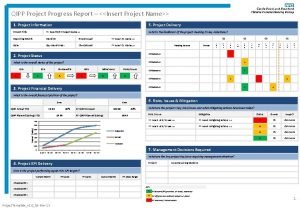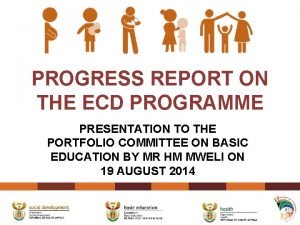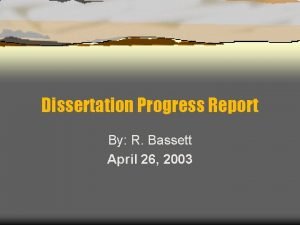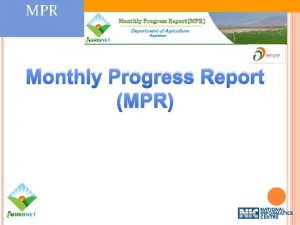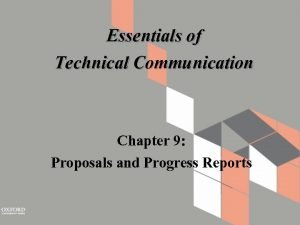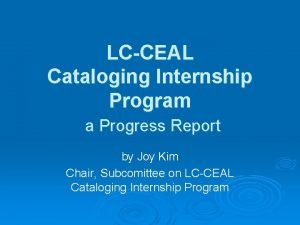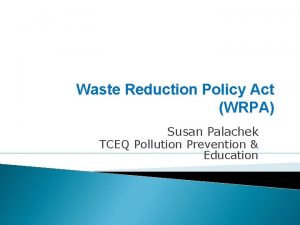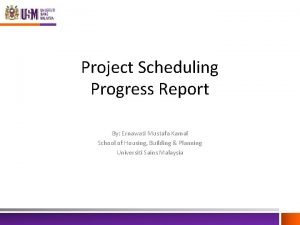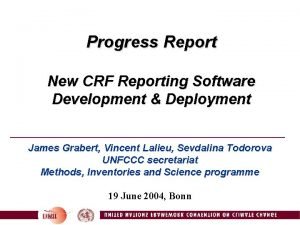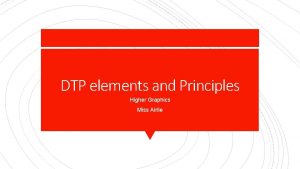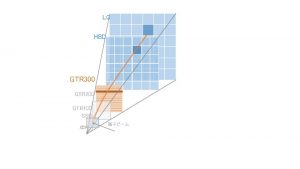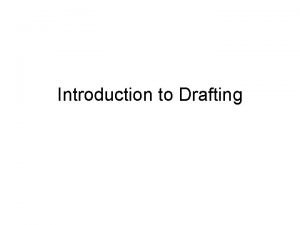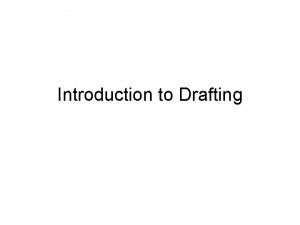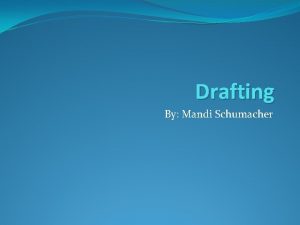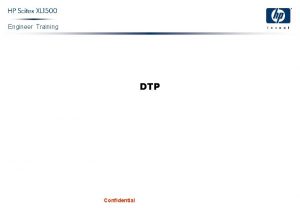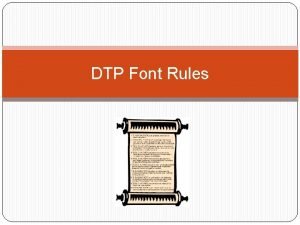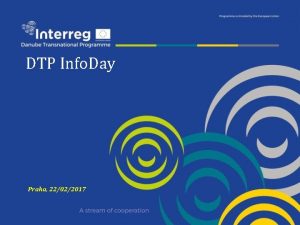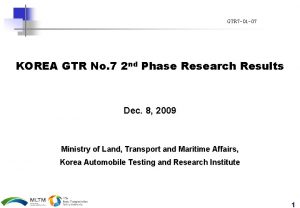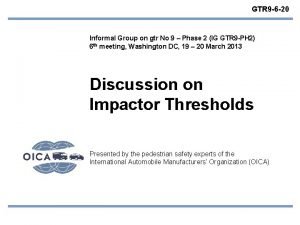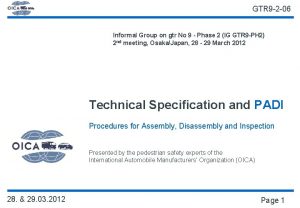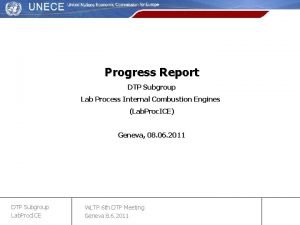DTP 14 and GTR Drafting Progress Report 66

















- Slides: 17

DTP 14 and GTR Drafting Progress Report 66 th GRPE 6 th June 2013

Overview • • • Good progress made since last GRPE 2 DTP meetings in Tokyo and Geneva 3 phone conferences Several meetings of the sub-groups On-going drafting group meetings (audio/web or f 2 f) • Inf. Doc GRPE-66 -02: Draft GTR WLTP

Sub-Group Reports • PM/PN subgroup has closed all open issues and concentrates its work on drafting. • AP subgroup has completed the work on N 20 and NO 2 measurement. Et. Oh-, NH 3 - and Aldehyde measurement will be added at a later stage. • EV subgroup has closed all major open issues for Phase 1 except Utility Factor (will be determined on a regional basis). Some issues still depend on the outcome of the confirmation phase. All vehicles will be classified as Class 3. • ICE subgroup has completed the new test mass approach (the method is however not yet fully validated), but still has to deal with some minor open issues.

Remaining Open Issues from DTP 14 1. 2. 3. 4. 5. 6. RCB correction for low-voltage battery Table of running resistances Comparison of RLD methods Vehicle warm-up procedure Speed trace violation Definition of predominant mode for multimode gearboxes 7. Ambient temperature for coastdown 8. Temperature correction for regional representativeness

1. RCB Correction Issue: The So. C of the low voltage battery has an impact on fuel consumption. This impact shall be considered appropriately. Proposal: So. C will be monitored via OBD data for a worst case family member. The definition of such a family is still an open issue. Correction of fuel consumption if delta RCB> [0, 5 %] on the basis Willans factors. Decision: The principles of this proposal is agreed. TÜV Nord and VW will cover the open issue of family criteria and validation procedure and present a paper to the next Lab. Proc. ICE meeting.

2. Table of Running Resistances (red) Issue: Default values for dyno settings may be applied if the Road Load of a vehicle cannot be determined (for example via coastdown). Proposal: Default values will be calculated on the basis of Cw*A and vehicle mass. The default values should orient towards worst case. Decision: A new proposal from TNO and RDW, which is based on a physical model to determine the road load and which applies an additional 3 k. W margin is estimated to be a promising approach. The group agrees to continue the RLD based approach. However additional data is requested. Lab. Proc ICE is asked to continue to work on this approach until August. At least the principle approach/procedure has to be agreed until August in order to bring it into the GTR. Parameter definition could be postponed to November – if Steering Group agrees. As a fallback solution there will be regional default tables.

3. Comparison of RLD Methods Issue: Apart from the coastdown there are other methods to determine the road load (torque meter, wind tunnel measuring) Proposal: The new RLD methods should be allowed, if the equivalency and accuracy of the new methods can be shown. The torque meter method has been proven to be equivalent to the coastdown method. Decision: Torque meter and coastdown methods will be included in the GTR. Wind tunnel method can become a subject for Phase 2.

4. Warm-Up Procedure (red) Issue: Preconditioning of the vehicle for RLD and for dyno load setting. Proposal: The majority of the Lab. Proc. ICE experts are in favour of defining stable vehicle conditions as a recommendation for warm-up. Japanese experts prefer a dedicated warm-up procedure. Decision: Lab. Proc. ICE experts presented a new approach based on a WLTC warm-up cycle for dyno load setting; Lab. Proc. ICE is asked to work out this approach and to provide a document before August.

5. Speed Trace Violation Issue: Deviations occuring outside the prescribed tolerances when following the speed trace of the test cycle. Proposal: The Lab. Proc. ICE proposal is in principle accepted, but values have to be confirmed. It is still unclear how to deal with vehicles which cannot follow the cycle. Decision: The proposal is welcomed by the group. India proposes to allow 1 % time deviation instead 10 deviations. The DHC Secretary accepted to introduce a common proposal on the basis of the Lab. Proc. ICE work. This proposal will also take into consideration vehicles that cannot follow the cycle.

6. Definition of Predominant Mode Issue: Vehicles with multi-mode gearboxes shall be tested in the predominant mode. Therefore, a stable definition is needed. Proposal: Lab. Proc. ICE has worked out a definition. NL still has reservations and is asked to come up with an improved definition. Decision: Despite the fact that the wording of the definition of the predominant mode is not perfect, the DTP group agrees to accept the current definition of the predominant mode.

7. Ambient Temperature for coastdown Issue: Definition of an allowed temperature range for coastdown. Proposal: EU proposes 5 -35°C; India proposes 5 -45°C. If no agreement can be found, the temperature range could be defined on a regional basis. Decision: A compromise proposal by India to restrict the temperature range up to 40°C could be acceptable by contracting parties. This could be accepted by EU-COM with the addition, that deviations of +/- 5°C are allowed. OICA has reservations of possible disharmonisation.

8. Temperature Correction for Regional Representative Conditions Issue: Supplemental test for determination of CO 2 under representative regional conditions. Proposal: Additional vehicle test under representative conditions for a representative family. The details of such a concept still have to be worked out. Decision: The principles of such an additional test are accepted. OICA will present a stable test procedure as well as a family concept and a validation program by the end of July. The procedure still has to be validated. EVs shall also be taken into account.

Drafting Overview • GTR available as an informal document on the GRPE site • GTR uploaded regularly to the CIRCABC website • Formation of drafting group consisting of representatives of the subgroups PM/PN, additional pollutants, electrified vehicles, lab procedures, steering group, contracting parties • Purpose, scope, application: covers only mono-fuel, ICE and EV vehicles

Major Open Drafting Points • Road and dynamometer load • Masses • Vehicle selection • Tyre selection Vehicle warming up Tyre slip on dyno Running resistance table Symbols and abbreviations: too extensive in current GTR • Latest cycle and shifting recommendation material to be integrated • •

Drafting Deadlines • Before end of June: Results from this GRPE to be analysed and incorporated into the GTR • End of June: f 2 f drafting group meeting in Brussels • Early July: Draft to be sent to WLTP members with comments expected no later than July 19 • July 19 to last week of July: Incorporation of comments received above • Last week of July: Drafting group meeting (either f 2 f or audio/web) • August 1 - 22: Finalisation of draft • August 23: Last date for submitting a Working Document to the UN for the November ad hoc GRPE meeting. • November 22: Ad hoc GRPE meeting • Mid-December: Last date for submitting a Working Document to the UN for the March meeting of WP. 29/AC. 3 • March 2014: Possible vote on the WLTP-GTR in WP. 29/AC 3

New GTR Structure A. Statement of technical justification B. Text of Regulation Annexes B. Text of Regulation 1. Cycles B. 1. Purpose 2. Shifting B. 2. Scope/Application 3. Fuels B. 3. Definitions 4. Road and dyno load B. 4. Symbols, abbreviations 5. Equipment B. 5. General requirements 6. Calculations B. 6. Performance requirements 7. System equivalence B. 7. Test procedure B. 8. Electrified vehicles

Next DTP-Meetings • Web/Phone Conference 25. 7. 2013 9 h 30 -12 h 00 CET • Further Web/Phone conferences possible later
 Difference between progress report and status report
Difference between progress report and status report Physical progress and financial progress
Physical progress and financial progress Qipp agenda
Qipp agenda Absorption of grade r practitioners 2022
Absorption of grade r practitioners 2022 Final year project presentation template
Final year project presentation template Dissertation progress report yale
Dissertation progress report yale Brief memo
Brief memo Mpr monthly progress report format
Mpr monthly progress report format Essentials of technical communication
Essentials of technical communication Progress report for internship
Progress report for internship Growing success grade chart
Growing success grade chart Tceq p2 annual progress report
Tceq p2 annual progress report Seo status report
Seo status report Progress report example
Progress report example Crf reporter
Crf reporter Connesct
Connesct Advantages of using desktop publishing software
Advantages of using desktop publishing software Dtp stands for desktop publishing.
Dtp stands for desktop publishing.


